5-Azido-4-dimethylamino-1-methyl-1,2,4-triazolium Hexafluoridophosphate and Derivatives
Abstract
:1. Introduction
2. Results and Discussion
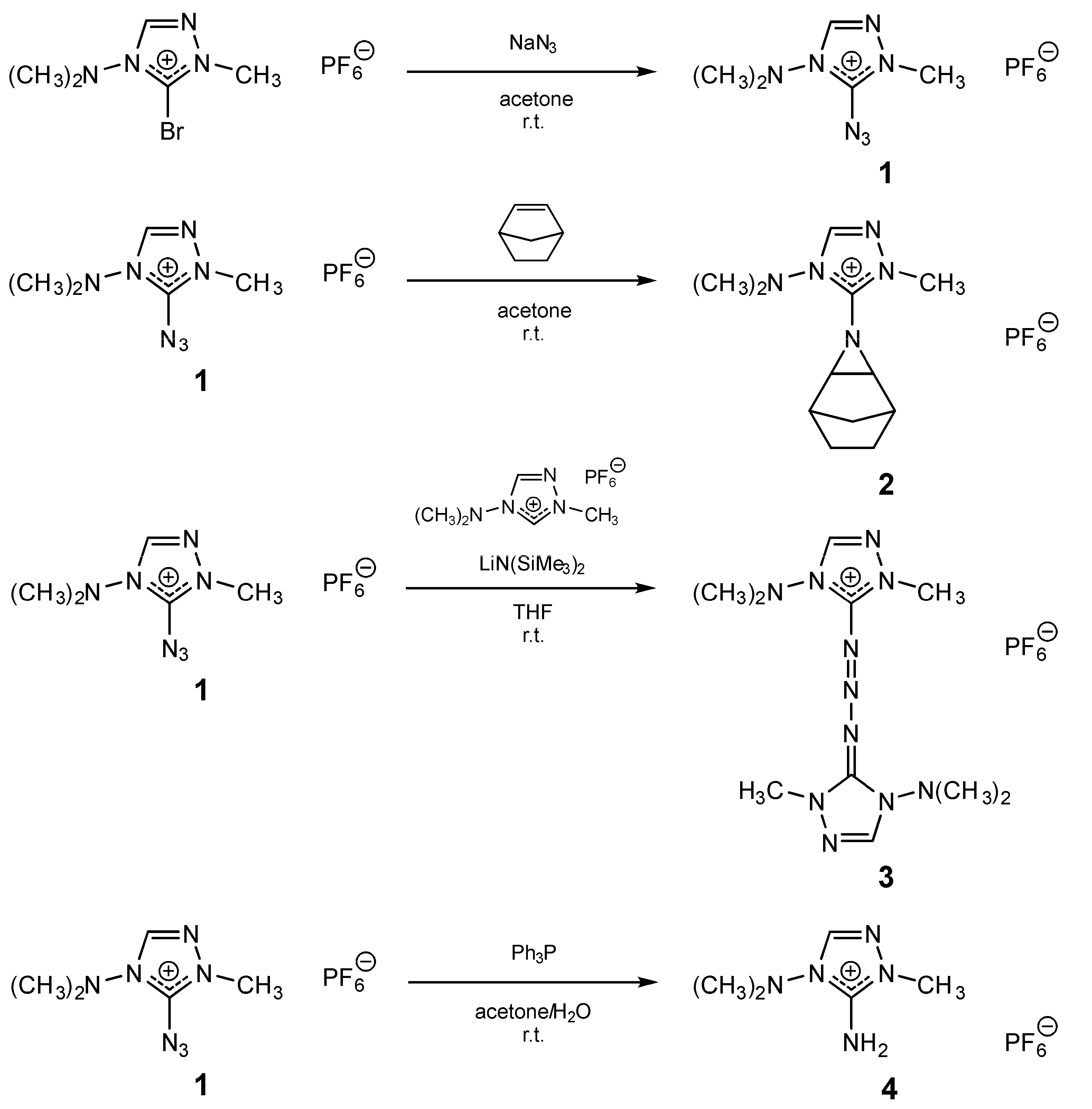
| Compound | 1 | 2 | 3 |
|---|---|---|---|
| CCDC No. | 1444906 | 1444907 | 1444908 |
| Empirical formula | C5H10N7·F6P | C12H20N5·F6P | C10H20N11·F6P |
| Formula weight | 313.17 | 379.30 | 439.34 |
| Crystal system | Monoclinic | Orthorhombic | Monoclinic |
| Space group | P21/n | Pnma | P21/n |
| a/Å | 7.6592(2) | 16.8383(3) | 9.6566(6) |
| b/Å | 11.3231(4) | 8.6698(2) | 18.3957(8) |
| c/Å | 13.9886(4) | 11.6179(2) | 11.6647(7) |
| β/° | 101.275(3) | 113.308(7) | |
| Volume/Å3 | 1189.76(6) | 1696.04(6) | 1903.0(2) |
| Z | 4 | 4 | 4 |
| Dx/g·cm−3 | 1.75 | 1.49 | 1.53 |
| µ/mm−1 | 0.31 | 2.08 | 0.22 |
| F(000) | 632 | 784 | 904 |
| Radiation | MoKα | CuKα | MoKα |
| Crystal size/mm3 | 0.40 × 0.40 × 0.40 | 0.40 × 0.28 × 0.24 | 0.39 × 0.12 × 0.09 |
| θmax/° | 25.4 | 67.4 | 25.4 |
| Index ranges | –9 ≤ h ≤ 9 | –19 ≤ h ≤ 20 | –11 ≤ h ≤ 11 |
| –13 ≤ k ≤ 12 | –10 ≤ k ≤ 10 | –21 ≤ k ≤ 21 | |
| –14 ≤ l ≤ 16 | –13 ≤ l ≤ 13 | –12 ≤ l ≤ 14 | |
| Reflections collected | 7844 | 9779 | 10926 |
| Independent reflections (Rint) | 2185 (0.023) | 1630 (0.033) | 3452 (0.032) |
| Observed reflections [I ≥ 2σ(I)] | 1777 | 1523 | 2845 |
| Restraints/parameters | 0/176 | 0/195 | 57/307 |
| Goodness-of-fit on F2 | 1.09 | 1.07 | 1.01 |
| R1, wR2 [I > 2σ(I)] | 0.027, 0.067 | 0.058, 0.158 | 0.049, 0.122 |
| R1, wR2 (all data) | 0.034, 0.068 | 0.061, 0.161 | 0.060, 0.130 |
| Largest diff. peak and hole/e·Å−3 | 0.19, −0.30 | 0.30, −0.26 | 0.44, −0.32 |
| 1 | 3 | |
|---|---|---|
| C1-N5 | 1.367(2) | 1.357(3) |
| N5-N6 | 1.255(2) | 1.303(3) |
| N6-N7 | 1.118(29) | 1.302(3) |
| N7-C6 | 1.352(4) | |
| C1-N5-N6 | 116.6(1) | 112.7(2) |
| N5-N6-N7 | 168.8(2) | 109.8(2) |
| N6-N7-C6 | 114.0(2) | |
| C1-N5-N6-N7 | 171.9(8) | 176.8(2) |
| N5-N6-N7-C6 | 178.4(2) |
| Compound | Interaction | H...F | C...F | C–H...F | Symmetry Operation F |
|---|---|---|---|---|---|
| 1 | C2–H...F1 | 2.329 | 3.263(2) | 167.7 | x, y, z |
| C2–H...F2 | 2.399 | 3.133(2) | 133.9 | x, y, z | |
| C5–HC...F4 | 2.468 | 3.416(2) | 162.8 | 1 + x, y, z | |
| C3–HA...F4 | 2.530 | 3.425(2) | 151.8 | 1/2 + x, 3/2 − y, −1/2 + z | |
| 2 | C2–H...F3 | 2.383 | 3.281 | 157.4 | –1/2 + x, 1/2 − y, 3/2 − z |
| C4–HA...F2 | 2.298 | 3.227(7) | 158.0 | 1/2 − x, −1/2 + y, −1/2 + z | |
| C10–H...F1 | 2.396 | 3.206(6) | 137.5 | x, y, z | |
| C6–H...F1 | 2.458 | 3.397(5) | 156.5 | 1/2 − x, 1/2 + y, −1/2 + z | |
| 3 | C7–H...F4 | 2.283 | 3.15(1) | 152.0 | 1 − x, −y, 1 − z |
| C2–H...F1 | 2.298 | 3.16(1) | 151.0 | 3/2 − x, 1/2 + y, 3/2 − z | |
| C5–HC...F3 | 2.432 | 3.211(5) | 136.2 | 3/2 − x, 1/2 + y, 3/2 − z | |
| C9–HB...F5 | 2.523 | 3.485(5) | 167.1 | x, y, 1 + z |
2.1. Crystal Structures
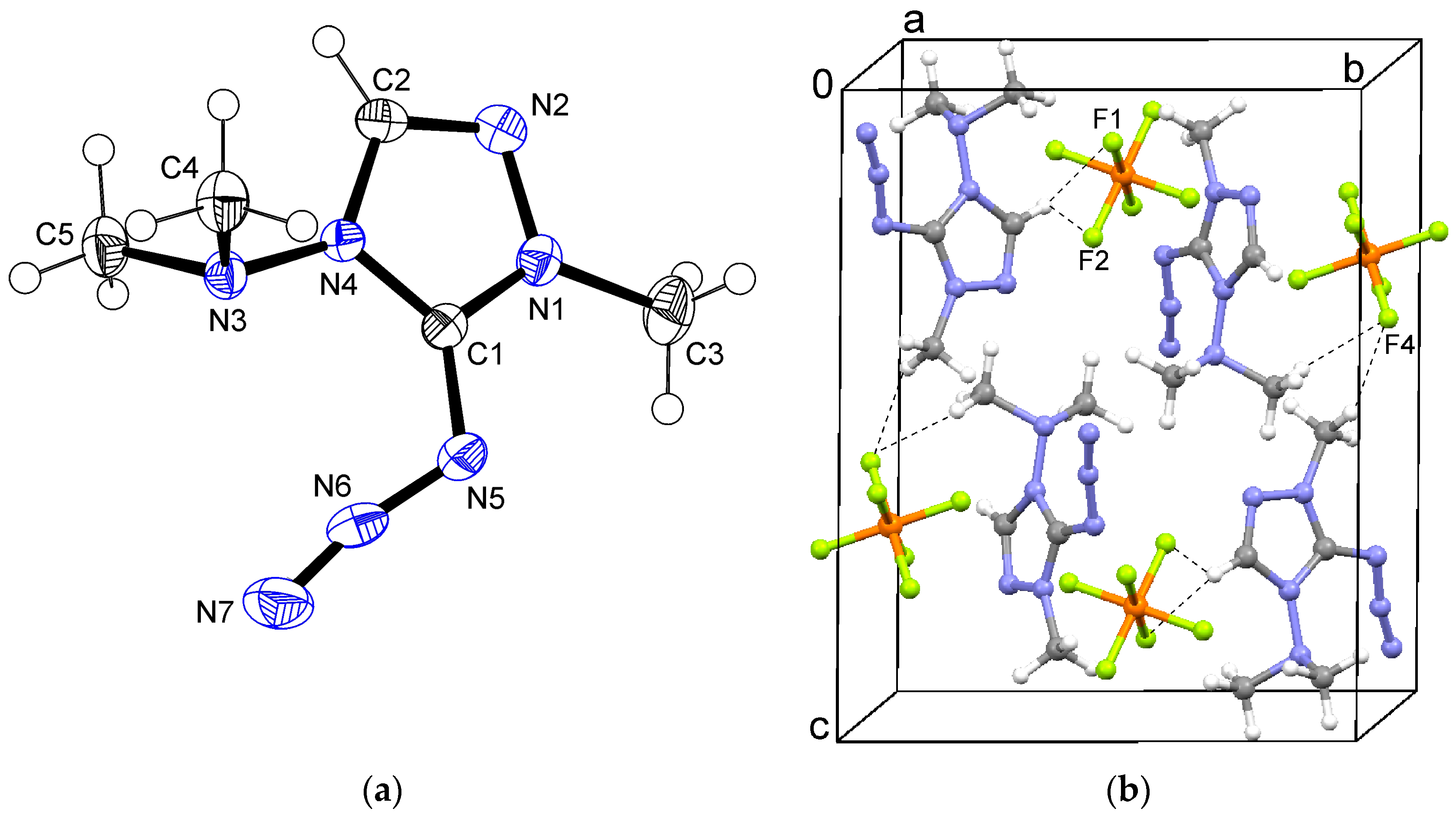
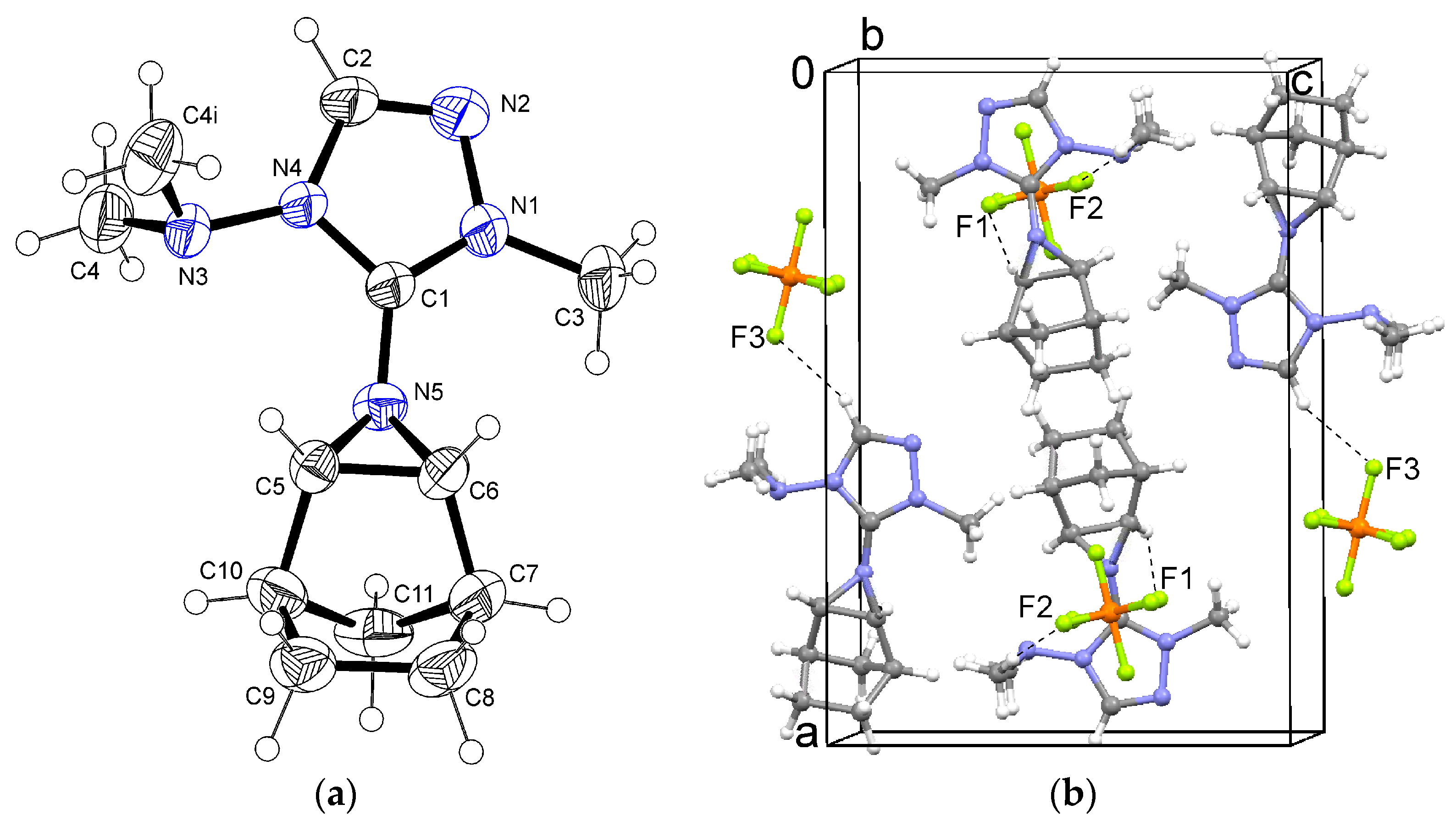
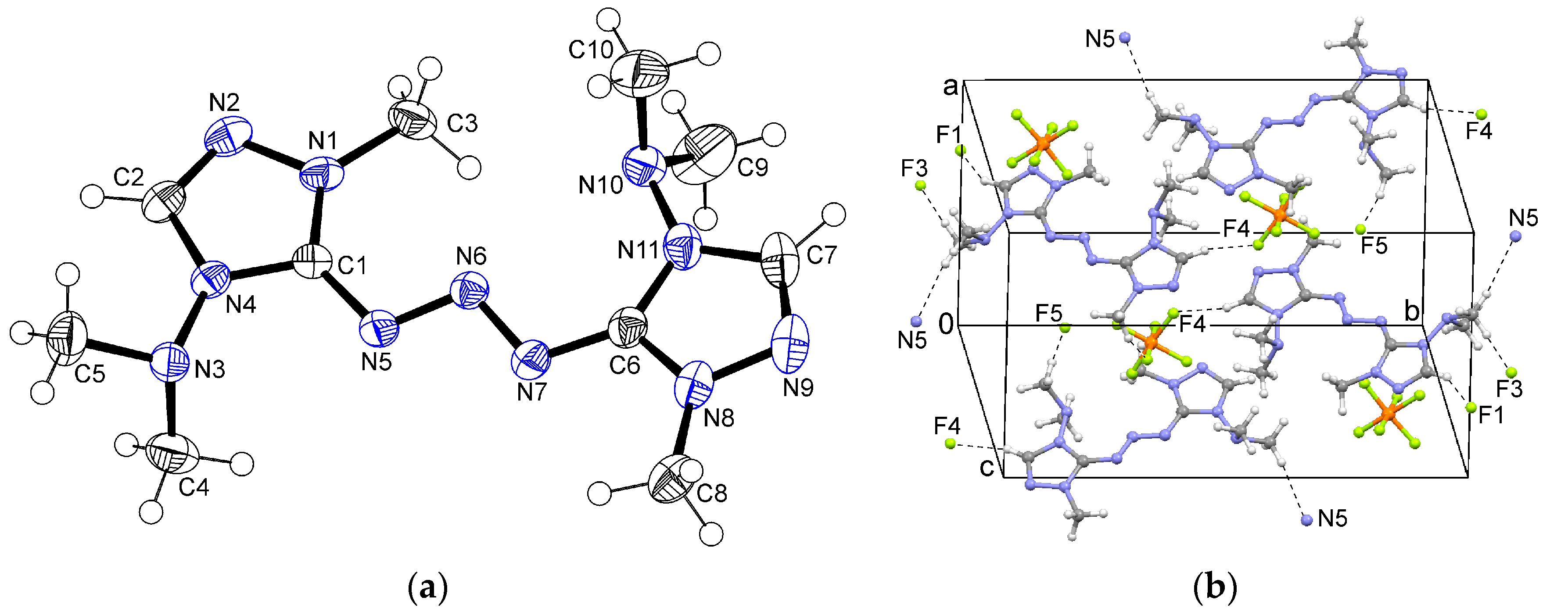
2.2. UV Spectroscopy
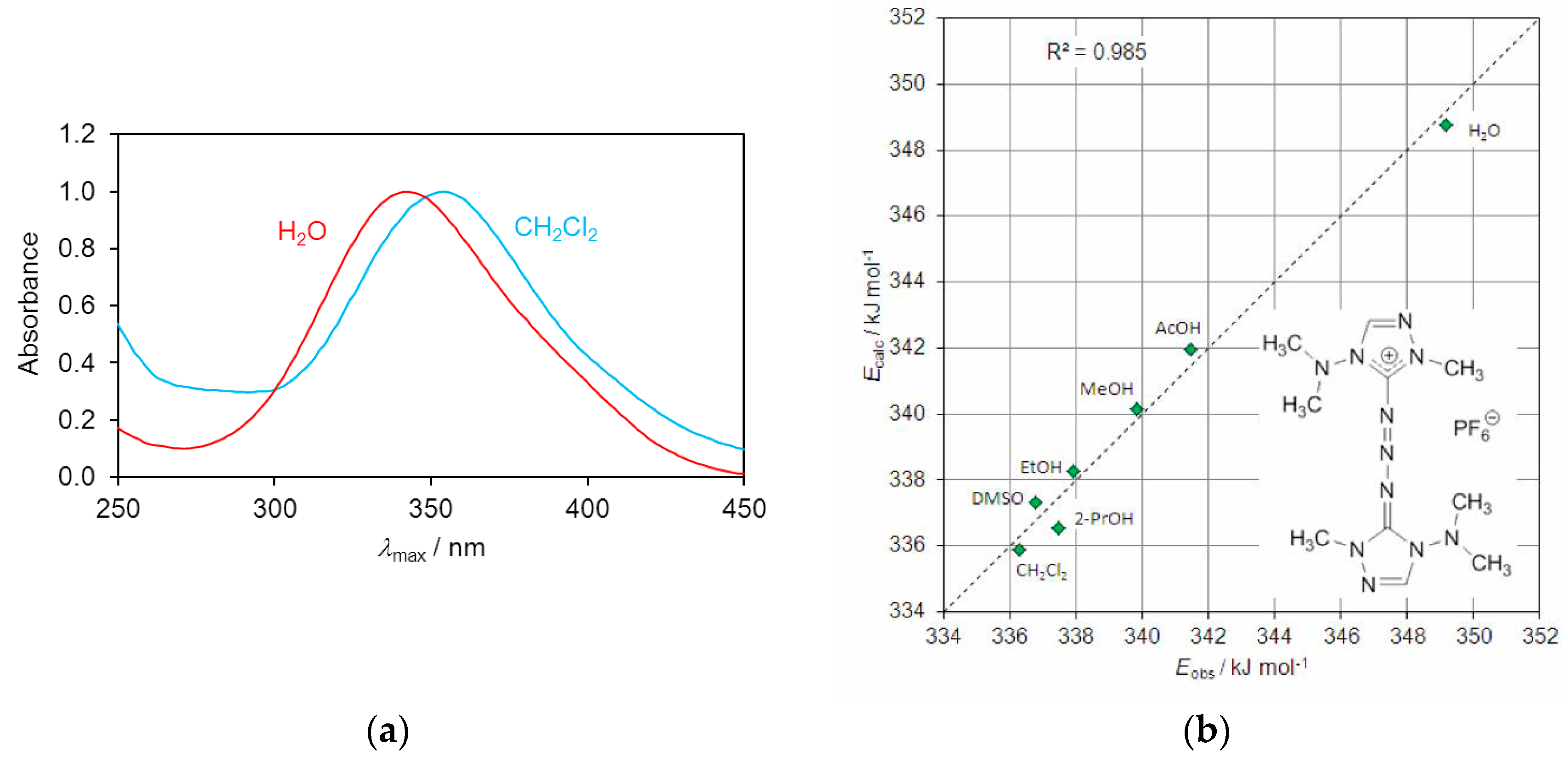
2.3. Differential Scanning Calorimetry (DSC) and Thermogravimetric Analysis (TGA)

3. Experimental Section
3.1. 5-Azido-4-(dimethylamino)-1-methyl-1,2,4-triazolium Hexafluoridophosphate (1)
3.2. 5-(3-Azatricyclo[3.2.1.02,4]oct-3-yl)-4-(dimethylamino)-1-methyl-1,2,4-triazolium Hexafluorido-Phosphate (2)
3.3. 4-(Dimethylamino)-1-methyl-5-(1-(4-(dimethylamino)-1-methyl-1,2,4-triazolin-5-ylidene)triazen-3-yl)-1,2,4-triazolium Hexafluoridophosphate (3)
3.4. 4-(Dimethylamino)-1-methyl-5-amino-1,2,4-triazolium Hexafluoridophosphate (4)
4. Conclusions
Acknowledgments
Author Contributions
Conflicts of Interest
References
- Hammerl, A.; Klapötke, T.M.; Mayer, P.; Weigand, J.J. Synthesis, structure, molecular orbital calculations and decomposition mechanism for tetrazolylazide CHN7, its phenyl derivative PhCN7 and tetrazolylpentazole CHN9. Propellants Explos. Pyrotech. 2005, 30, 17–26. [Google Scholar] [CrossRef]
- Klapötke, T.M.; Stierstorfer, J. The CN7− anion. J. Am. Chem. Soc. 2009, 131, 1122–1134. [Google Scholar] [CrossRef] [PubMed]
- Stierstorfer, J.; Klapötke, T.M.; Hammerl, A.; Chapman, R.D. 5-Azido-1H-tetrazole—Improved synthesis, crystal structure and sensitivity data. Z. Anorg. Allg. Chem. 2008, 634, 1051–1057. [Google Scholar] [CrossRef]
- Izsák, D.; Klapötke, T.M. Preparation and crystal structure of 5-Azido-3-nitro-1H-1,2,4-triazole, Its methyl derivative and potassium salt. Crystals 2012, 2, 294–305. [Google Scholar] [CrossRef]
- Qi, C.; Li, S.H.; Li, Y.C.; Wang, Y.; Zhao, X.X.; Pang, S.P. Synthesis and promising properties of a new family of high-nitrogen compounds: Polyazido- and polyamino-substituted N,N′-Azo-1,2,4-triazoles. Chem. Eur. J. 2012, 18, 16562–16570. [Google Scholar] [CrossRef] [PubMed]
- Izsák, D.; Klapötke, T.M.; Reuter, S.; Rösener, T. Silver salt and derivatives of 5-Azido-1H-1,2,4-triazole-3-carbonitrile. Z. Anorg. Allg. Chem. 2013, 639, 899–905. [Google Scholar] [CrossRef]
- Balli, H.; Maul, R. Azidiniumsalze und Triazatrimethincyanine substituierter Benzimidazole. Helv. Chim. Acta 1976, 59, 148–155. (In German) [Google Scholar] [CrossRef]
- Balli, H.; Löw, R. Azidiniumsalze und Triazatrimethincyanine substituierter Thiazole. Helv. Chim. Acta 1976, 59, 155–164. (In German) [Google Scholar] [CrossRef]
- Lehmann, U.; Balli, H. Ansa-triazacarbocyanine der [n](1,3)-benzimidazolophan-reihe: Synthese, spektroskopische untersuchungen und photochemische eigenschaften. Dyes Pigment. 1983, 4, 121–161. (In German) [Google Scholar] [CrossRef]
- Xue, H.; Gao, Y.; Twamley, B.; Shreeve, J.M. New energetic salts based on nitrogen-containing heterocycles. Chem. Mater. 2005, 17, 191–198. [Google Scholar] [CrossRef]
- Laus, G.; Schwärzler, A.; Schuster, P.; Bentivoglio, G.; Hummel, M.; Wurst, K.; Kahlenberg, V.; Lörting, T.; Schütz, J.; Peringer, P.; et al. N,N′-Di(alkyloxy)imidazolium salts: new patent-free ionic liquids and NHC precatalysts. Z. Naturforsch. 2007, 62, 295–308. [Google Scholar] [CrossRef]
- Kitamura, M.; Kato, S.; Yano, M.; Tashiro, N.; Shiratake, Y.; Sando, M.; Okauchi, T. A reagent for safe and efficient diazo-transfer to primary amines: 2-azido-1,3-dimethylimidazolinium hexafluorophosphate. Org. Biomol. Chem. 2014, 12, 4397–4406. [Google Scholar] [CrossRef] [PubMed]
- Khramov, D.M.; Bielawski, C.W. Triazene formation via reaction of imidazol-2-ylidenes with azides. Chem. Commun. 2005, 4958–4960. [Google Scholar] [CrossRef] [PubMed]
- Khramov, D.M.; Bielawski, C.W. Donor-acceptor triazenes: Synthesis, characterization, and study of their electronic and thermal properties. J. Org. Chem. 2007, 72, 9407–9417. [Google Scholar] [CrossRef] [PubMed]
- Patil, S.; Bugarin, A. Crystal structure of (E)-1,3-dimethyl-2-[3-(3-nitrophenyl)- triaz-2-en-1-ylidene]-2,3-dihydro-1H-imidazole. Acta Crystallogr. 2014, 70, 224–227. [Google Scholar] [CrossRef] [PubMed]
- Kunetskiy, R.A.; Cisarova, I.; Saman, D.; Lyapkalo, I.M. New lipophilic 2-Amino-N,N′-dialkyl-4,5-dimethylimidazolium cations: Synthesis, structure, properties, and outstanding thermal stability in alkaline media. Chem. Eur. J. 2009, 15, 9477–9485. [Google Scholar] [CrossRef] [PubMed]
- Lysenko, S.; Daniliuc, C.G.; Jones, P.G.; Tamm, M. Tungsten alkylidyne complexes with ancillary imidazolin-2-iminato and imidazolidin-2-iminato ligands and their use in catalytic alkyne metathesis. J. Organomet. Chem. 2013, 744, 7–14. [Google Scholar] [CrossRef]
- Tennyson, A.G.; Moorhead, E.J.; Madison, B.L.; Er, J.A.V.; Lynch, V.M.; Bielawski, C.W. Methylation of ylidene-triazenes: Insight and guidance for 1,3-dipolar cycloaddition reactions. Eur. J. Org. Chem. 2010, 6277–6282. [Google Scholar] [CrossRef]
- Patil, S.; White, K.; Bugarin, A. Novel triazene dyes from N-heterocyclic carbenes and azides: Syntheses, stability, and spectroscopic properties. Tetrahedron Lett. 2014, 55, 4826–4829. [Google Scholar] [CrossRef]
- Patil, S.; Bugarin, A. Fifty years of π-conjugated triazenes. Eur. J. Org. Chem. 2015. [Google Scholar] [CrossRef]
- Naef, R.; Balli, H. Synthesis, structure and photochemical properties of 4,4′,7,7′-tetra-substituted 1,1′,3,3′-tetraethylbenzimidazolotriazatrimethine cyanines. Helv. Chim. Acta 1978, 61, 2958–2973. [Google Scholar] [CrossRef]
- Bräse, S.; Gil, C.; Knepper, K.; Zimmermann, V. Organic azides: An Exploding diversity of a unique class of compounds. Angew. Chem. Int. Ed. 2005, 44, 5188–5240. [Google Scholar] [CrossRef] [PubMed]
- Henery-Logan, K.R.; Clark, R.A. The reaction of phenyl azide with olefins. Tetrahedron Lett. 1968, 9, 801–806. [Google Scholar] [CrossRef]
- Alder, K.; Stein, G. Über das abgestufte Additionsvermögen von ungesättigten Ringsystemen. Justus Liebigs Ann. Chem. 1933, 501, 1–48. (In German) [Google Scholar] [CrossRef]
- Scheiner, P.; Schomaker, J.H.; Deming, S.; Libbey, W.J.; Nowack, G.P. The addition of aryl azides to norbornene. A kinetic investigation. J. Am. Chem. Soc. 1965, 87, 306–311. [Google Scholar] [CrossRef]
- Haslinger, S.; Laus, G.; Wurst, K.; Schottenberger, H. Crystal structure of 1-(1-methyl-1H-imidazol-2-yl)-4-phenyl-1H-1,2,3-triazole dihydrate. Acta Cryst. 2015, 71, o945–o946. [Google Scholar] [CrossRef]
- Chopra, D.; Guru Row, T.N. Role of organic fluorine in crystal engineering. CrystEngComm 2011, 13, 2175–2186. [Google Scholar] [CrossRef]
- D’Oria, E.; Novoa, J.J. On the hydrogen bond nature of the C–H...F interactions in molecular crystals. An exhaustive investigation combining a crystallographic database search and ab initio theoretical calculations. CrystEngComm 2008, 10, 423–436. [Google Scholar] [CrossRef]
- Kamlet, M.J.; Abboud, J.L.M.; Taft, R.W. The solvatochromic comparison method. The π* scale of solvent polarities. J. Am. Chem. Soc. 1977, 99, 6027–6038. [Google Scholar] [CrossRef]
- Taft, R.W.; Kamlet, M.J. The solvatochromic comparison method. The α scale of solvent hydrogen-bond donor (HBD) acidities. J. Am. Chem. Soc. 1976, 98, 2886–2894. [Google Scholar] [CrossRef]
- Kamlet, M.J.; Taft, R.W. The solvatochromic comparison method. The β scale of solvent hydrogen-bond acceptor (HBA) basicities. J. Am. Chem. Soc. 1976, 98, 377–383. [Google Scholar] [CrossRef]
- Marcus, Y. The properties of organic liquids that are relevant to their use as solvating solvents. Chem. Soc. Rev. 1993, 409–416. [Google Scholar] [CrossRef]
- Schwärzler, A.; Laus, G.; Kahlenberg, V.; Wurst, K.; Gelbrich, T.; Kreutz, C.; Kopacka, H.; Bonn, G.; Schottenberger, H. Quaternary 4-amino-1,2,4-triazolium salts: Crystal structures of ionic liquids and N-heterocyclic carbene (NHC) complexes. Z. Naturforsch. 2009, 64, 603–616. [Google Scholar] [CrossRef]
© 2016 by the authors; licensee MDPI, Basel, Switzerland. This article is an open access article distributed under the terms and conditions of the Creative Commons by Attribution (CC-BY) license (http://creativecommons.org/licenses/by/4.0/).
Share and Cite
Laus, G.; Kahlenberg, V.; Schottenberger, H. 5-Azido-4-dimethylamino-1-methyl-1,2,4-triazolium Hexafluoridophosphate and Derivatives. Crystals 2016, 6, 20. https://doi.org/10.3390/cryst6020020
Laus G, Kahlenberg V, Schottenberger H. 5-Azido-4-dimethylamino-1-methyl-1,2,4-triazolium Hexafluoridophosphate and Derivatives. Crystals. 2016; 6(2):20. https://doi.org/10.3390/cryst6020020
Chicago/Turabian StyleLaus, Gerhard, Volker Kahlenberg, and Herwig Schottenberger. 2016. "5-Azido-4-dimethylamino-1-methyl-1,2,4-triazolium Hexafluoridophosphate and Derivatives" Crystals 6, no. 2: 20. https://doi.org/10.3390/cryst6020020
APA StyleLaus, G., Kahlenberg, V., & Schottenberger, H. (2016). 5-Azido-4-dimethylamino-1-methyl-1,2,4-triazolium Hexafluoridophosphate and Derivatives. Crystals, 6(2), 20. https://doi.org/10.3390/cryst6020020






